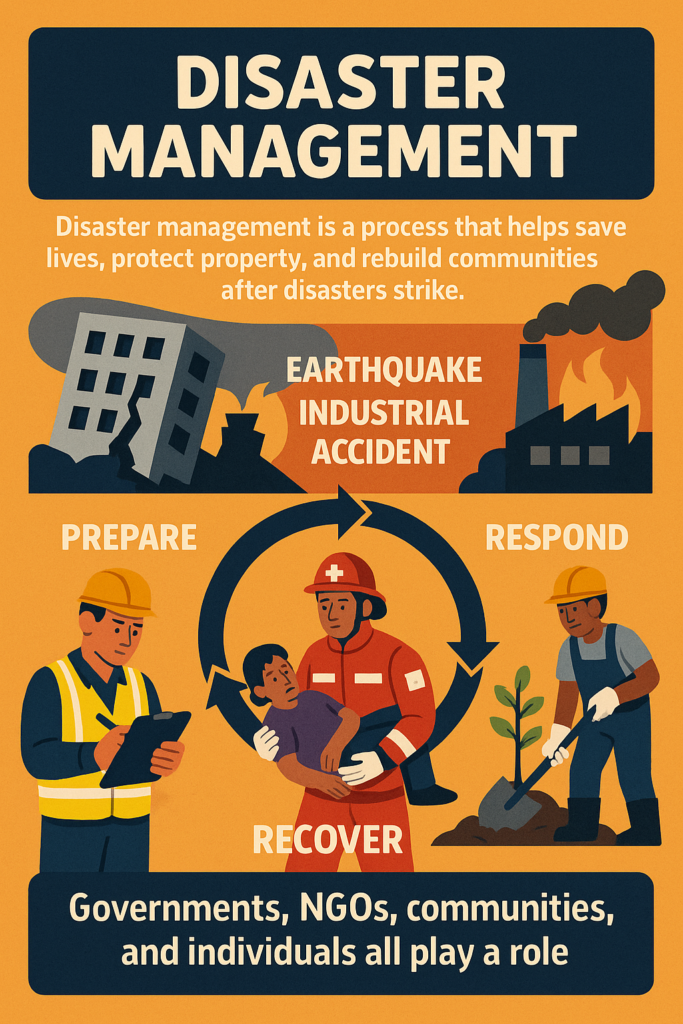Disaster Management
Disaster management is the process of preparing for, responding to, and recovering from disasters. A disaster can be anything that causes significant harm to people, property, and the environment. This includes both natural events like earthquakes and human-made incidents like industrial accidents. The goal of disaster management is to reduce the impact of these events, save lives, and help communities recover as quickly as possible.

Types of Disasters
Disasters can be broadly classified into two categories: natural disasters and human-made disasters.
1. Natural Disasters
These disasters occur due to natural processes of the Earth. They are usually unpredictable and can cause widespread damage. Some common natural disasters include:
- Earthquakes: Sudden shaking of the ground caused by movements in the Earth’s crust. They can lead to building collapses, landslides, and even tsunamis.
- Floods: Overflow of water onto normally dry land, often due to heavy rainfall, storms, or melting snow. Floods can destroy homes, crops, and infrastructure.
- Cyclones: Also known as hurricanes or typhoons, these are powerful storms with strong winds and heavy rains. They can cause severe flooding, property damage, and loss of life.
2. Human-Made Disasters
These disasters result from human actions, either accidental or intentional. They can be prevented or minimized with proper safety measures. Some examples include:
- Industrial Accidents: Accidents that occur in factories or industries, such as chemical spills, explosions, or fires.
- Terrorism: Acts of violence, such as bombings, shootings, or attacks designed to cause fear, harm, or disruption.
Disaster Preparedness and Response
Disaster management involves two key stages: preparedness and response.
1. Preparedness
Preparedness means getting ready before a disaster strikes. This includes:
- Planning: Developing emergency plans for different types of disasters.
- Training: Teaching people and emergency services how to respond effectively.
- Stockpiling Supplies: Having emergency kits with food, water, medical supplies, and flashlights.
- Early Warning Systems: Using technology to predict disasters, such as weather forecasts for cyclones or earthquake alerts.
2. Response
The response phase happens during and immediately after a disaster. It focuses on saving lives and reducing damage. Key activities include:
- Rescue Operations: Helping people trapped under debris or in dangerous situations.
- Providing Emergency Relief: Distributing food, clean water, medicines, and temporary shelter.
- Medical Care: Setting up emergency clinics to treat injured people.
Role of Government and NGOs in Disaster Management
Both governments and non-governmental organizations (NGOs) play important roles in disaster management.
1. Government’s Role
Governments are responsible for:
- Policy Making: Developing laws and regulations for disaster preparedness and response.
- Resource Allocation: Providing funding, equipment, and personnel for emergency services.
- Coordination: Ensuring that different organizations work together efficiently during a disaster.
- Infrastructure Development: Building disaster-resistant buildings, roads, and communication networks.
2. NGOs’ Role
NGOs are private organizations that support disaster management through:
- Emergency Support: Providing food, water, shelter, and medical care to affected communities.
- Community Awareness: Educating people about disaster risks and how to prepare.
- Volunteering: Mobilizing volunteers to assist in rescue operations and recovery efforts.
- Long-Term Recovery: Helping rebuild communities after the immediate crisis has passed.
Conclusion
Disaster management is a vital process that helps save lives, protect property, and rebuild communities after disasters strike. Whether the disaster is natural or human-made, being prepared, having a solid response plan, and working together as a society can make a big difference. Governments and NGOs play key roles in managing disasters, but everyone—from individuals to communities—has a part to play in creating a safer, more resilient world.
Tags: awareness programs, Communication Systems, community safety, coordination, crisis management, Cyclone, Disaster management, disaster relief, disaster response teams, disaster-resistant buildings, early warning systems, Earthquake, emergency kits, emergency planning, emergency supplies, environmental impact., Flood, Government Role, human-made disasters, industrial accidents, Infrastructure, long-term recovery, medical aid, mitigation, Natural Disasters, NGOs, Policy-making, preparedness, public safety, rebuilding, recovery, rescue operations, resilience building, resource allocation, response, Risk reduction., terrorism, training and drills, tsunami, volunteer support.


